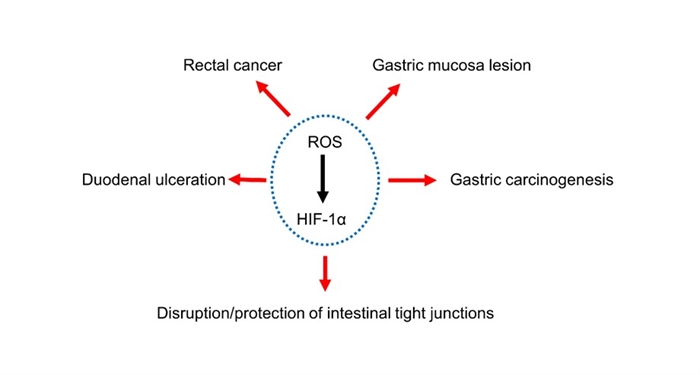How Interactions between Reactive Oxygen Species and Hypoxia-inducible Factors Influence Gastrointestinal Diseases
The gastrointestinal tract (GT) is the major organ involved in digestion, absorption, and immunity. It is prone to oxidative destruction by highly reactive oxygen species (ROS).
Recently, researchers from the Institute of Subtropical Agriculture (ISA) of the Chinese Academy of Sciences and their collaborators reviewed the interactions between hypoxia-inducible factor (HIF), mainly HIF-1α, and reactive oxygen species (ROS).
The study was published in Oxidative Medicine and Cellular Longevity on Jan.21.
Reactive oxygen species (ROS) are byproducts of normal cellular metabolism. Accumulated ROS will lead to oxidative stresses, which contribute to various diseases in the GT.
However, ROS also act as important signaling molecules in response to growth factors, hormones, and oxygen tension changes. Hypoxia-inducible factors (HIFs) are indispensable transcription factors in response to low oxygen.
Different sources of ROS participate in the modulation of HIF-1α and further play a role in the pathologic progress of various gastrointestinal diseases.
There is evidence that cigarette smoke exposure led to increased ROS, contributing to the disruption of intestinal tight junctions by upregulating HIF-1α expression in the rat small intestine.
However, Clostridium difficile toxin-mediated ROS play a key role in the stabilization of HIF-1α, leading to the innate protection of colon epithelial barrier function, which suggested that HIF-1α played a dual role in gastrointestinal diseases.
There are strong correlations between ROS and HIF-1α in the GT, which are as yet ill-defined. It is now evident that ROS regulate HIF-1α in different ways. However, the mechanism of ROS levels modulated by HIF-1α is vague and controversial.
Understanding the interactions between HIF and ROS may help developing new therapies for gastrointestinal diseases associated with ROS and HIF-1α.

Fig. 1 HIF-1α regulated by ROS play a role in gastrointestinal diseases. (Image by ISA)

Fig. 2 Interactions between HIF-1α and ROS in the gastrointestinal tract. (Image by ISA)
Contact: XIONG Xia
E-mail: xx@isa.ac.cn
F-Institute of Subtropical Agriculture, Chinese Academy of Sciences
Download attachments: